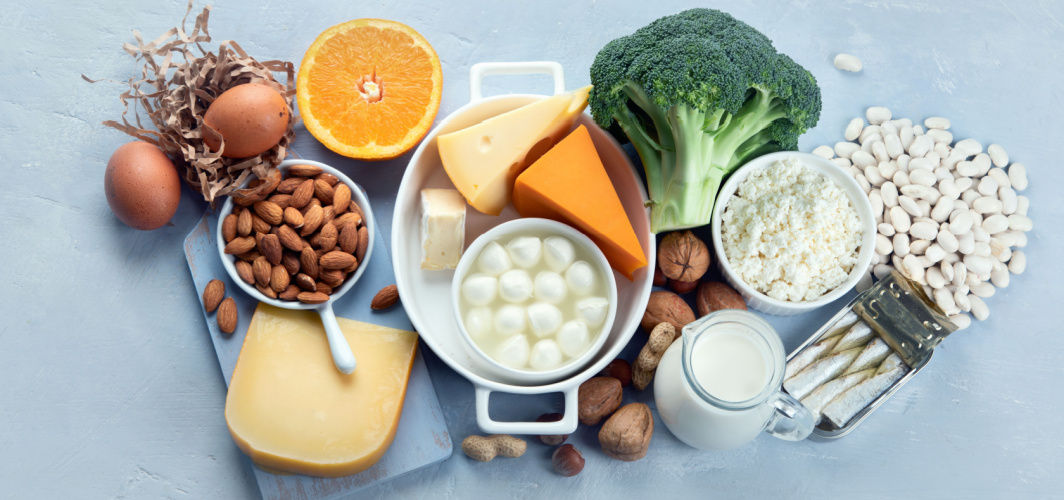Orthopedic Conditions
Top 12 Calcium-Rich Foods For Stronger Bones & Improved Health
8 min read
By Apollo Pharmacy, Published on - 16 August 2023, Updated on - 01 September 2023
Share this article
0
0 like

Calcium is a key player when it comes to maintaining strong bones and good overall health. It has many significant roles, such as developing strong bones and teeth, preventing excessive bleeding, and sustaining a regular heartbeat. However, sometimes, it can be difficult to find out the best calcium-rich foods, necessary to meet daily requirements. Below are some of the calcium-rich foods that are readily available and can easily be integrated into various meals.
Why Does Our Body Need Calcium?
For our body to operate effectively, calcium is a crucial mineral. It makes up around 2% of our adult body weight and is the mineral that is most prevalent in our bodies.
Calcium plays a significant role in the ongoing breakdown and reconstruction of our bones, as our bones can become weak and break easily without it, thus resulting in bone diseases such as osteoporosis.
However, it is essential for more than just our teeth and bones. Calcium is also crucial for blood clotting, neuron transmission, and muscle contraction. It is released from our cells to help our muscles move as they contract. Therefore, we need to build and maintain a calcium-rich diet or take calcium supplements for our bodies to stay strong and efficient.
12 Calcium-rich Foods to Add to Your Diet
To make things simple for you and provide your body with the boost it needs, we've put together a list of 12 calcium-rich foods, including vegetarian options.
1. Tofu
It is a soy-based food item that is high in calcium, iron, and protein. It is a fantastic source of nutrients for lactose-intolerant people as well as those who want to consume fewer animal products. It may be used in a wide range of savoury and sweet foods, and is easily adaptable to varied recipes.
Around 832 mg of calcium can be found in a cup of tofu, making it a superior source of this crucial mineral.
You can press and drain tofu to eliminate extra moisture, then cut it into cubes and marinate in soy sauce, sesame oil, garlic, and ginger. For a wholesome and delicious supper, serve with rice or steamed veggies.
2. Leafy Greens
Calcium is abundant in leafy greens, including spinach, kale, and collard greens. Incorporating these vegetables into our meals can be a smart way to enhance our overall nutrition.
Given that cooked collard greens have a calcium content of 141 mg per 100 grams, these leafy greens are a fantastic source of minerals. They also have significant amounts of other necessary vitamins and minerals, including magnesium, iron, and potassium. All of these are crucial for maintaining healthy bones and allowing the body to absorb calcium.
3. Almonds
They are a great plant-based source of calcium. The average amount of calcium in 15 almonds is around 40 mg.
The body easily absorbs almond-derived calcium. Moreover, they are an excellent source of fibre, healthy fats, and protein.
You may eat almonds in many ways, including raw, roasted, sliced, and crushed into flour. For people looking for calcium-fortified options, almond milk, a popular dairy milk substitute, is a practical choice.
4. Dairy Products
Milk, cheese, and yoghurt are examples of dairy products that are regarded as excellent calcium sources. Depending on the particular product and its fat composition, the precise amount of calcium may change. For instance, a 250 ml portion of milk contains roughly 300 mg of calcium.
Lactose and certain proteins in dairy products can improve the absorption of calcium. Due to their high digestibility, dairy products can greatly help you achieve your daily calcium requirements.
5. Salmon
It is a nutrient-rich fish that provides a significant quantity of calcium in addition to a wide range of other crucial nutrients.
Compared to dairy products or some plant-based sources, it is not typically seen as a high-calcium food. On average, just 85 grams of canned salmon provides about 181 mg of calcium.
6. Whole Grains
Whole grains, such as quinoa and amaranth, are also excellent sources of calcium. One cup of cooked quinoa contains 17 mg of calcium.
Moreover, whole grains contain many other essential minerals such as manganese, magnesium, phosphorus, and iron, which aid in the absorption of calcium in the body. The concentration of phytic acid (anti-nutrient) in whole grains can be lowered through soaking, fermenting, or sprouting.
7. Fortified Foods
Particularly for people who may have dietary limitations or struggle to satisfy their calcium needs through natural food sources, fortified foods can be an excellent source of calcium. In fact, the absorption of calcium from these foods can be up to 30%.
Common types of calcium used in fortification include calcium carbonate, calcium citrate, and calcium phosphate. The addition of calcium is meant to increase the food's nutritional value and serve as a handy supply of this crucial mineral.
To offer a comparable nutritional profile to dairy milk, calcium is frequently added to plant-based milk substitutes such as soy milk, almond milk, oat milk, and rice milk.
8. Figs
They are a fruit that is delicious, wholesome, and high in calcium. Nearly 162 mg of calcium is available in 100 g dried figs.
Figs are adaptable and may be used in a variety of ways. They can be consumed raw, added to salads, baked, or used as a garnish over yoghurt or porridge.
9. White Beans
This is an excellent addition to any Indian diet to pack a punch of calcium in a healthy and delicious form. You can get about 73 mg of calcium from 100 grams of cooked white beans.
10. Edamame
Cooked soybeans, or edamame, are also high in calcium. It is frequently eaten as a snack, entrée, or component in other cuisines. Notably, 100 grams of cooked edamame generally contains 63 mg of calcium or about 6% of the daily required value. Even though edamame has a moderate calcium content, it may be combined with other foods that are high in calcium to boost calcium intake.
11. Broccoli
A cruciferous vegetable, broccoli is rich in calcium and other minerals. The amount of calcium in 100 grams of cooked broccoli is about 47 mg. Compared to many other vegetables, broccoli has a notable quantity of calcium.
12. Sardines
Small, fatty sardines are a rich source of calcium and other minerals. Amongst fish, sardines are regarded as one of the greatest suppliers of calcium. Around 382 mg of calcium per 100 grams is normally included in canned sardines with bones, which is around 38% of the daily requirement.
Sardines include calcium, phosphorus, and vitamin D, which maintain healthy bones, promote bone growth, and guard against bone diseases such as osteoporosis.
How Much Calcium is Required by Our Body?
Depending on age, gender, and other circumstances, our body needs different amounts of calcium.
1. Adults: The daily calcium consumption for most adults is between 1000 mg and 1200 mg, with increased needs during pregnancy and breastfeeding. Thus, it is crucial to add calcium-rich foods for pregnancy to the diet. For the prevention of osteoporosis and bone loss in those over 50 years, calcium intake may need to be increased.
2. Children: The quantity of calcium that children require depends on their age. Children in the age group of 1-3 years need 700 mg of calcium daily, whereas those who are 4-8 years old require 1,000 mg, and 9-18 years old require 1,300 mg.
It is crucial to remember that consuming too much calcium can also be detrimental to health. It can lead to kidney stones and constipation, and stop the body from absorbing other important nutrients.
What are the Signs of Calcium Deficiency?
Knowing the symptoms of calcium deficiency is important since it may cause several different health issues. Here is a list of a few symptoms caused due to calcium deficiency:
- Muscle cramps are among the most prevalent symptoms of a calcium shortage. Insufficient calcium can cause the muscles to malfunction, resulting in excruciating cramps.
- A tingling sensation or numbness in the hands, feet, or face is another indicator of calcium shortage.
- Nails that are brittle and break easily are common signs of calcium deficiency.
If you are experiencing any of these signs, then it may be a symptom of calcium deficiency. Hence, it is essential to take the necessary steps to ensure you are taking enough calcium that your body requires. Additionally, your doctor may recommend calcium supplements to maintain the adequate amount required by your body.
Summary
Taking care of your bones does not have to be difficult. Add some yoghurt or a dash of cheese to your favourite dish to start the day with a calcium-rich breakfast. A few extra calcium-rich snacks throughout the day, such as nuts, seeds, and leafy greens, should then be consumed. Your bones will thank you for just a few easy modifications. You can make sure you're fulfilling your daily calcium needs and maintaining ideal bone health by including these calcium-rich foods for bones in your diet.
You may also explore calcium supplements if your diet fails to provide you with required amount of the nutrient.
FAQs
1. Is it possible to get all the calcium I need without having dairy products?
Absolutely! Even though dairy products are a well-liked source of calcium, there are many non-dairy options accessible. Leafy vegetables or fortified food can offer significant calcium content.
2. Do I need to take calcium supplements if I usually eat foods high in calcium?
In most situations, you may satisfy your calcium needs without taking supplements if you maintain a balanced diet that includes a range of calcium-rich foods.
3. Can consuming too much calcium be harmful?
While calcium is important for human health, taking too much of it in the form of supplements might increase the chance of developing kidney stones or blood vessel calcium accumulation.
4. Can heating change the amount of calcium in food?
The amount of calcium in some meals might vary depending on how they are cooked. For instance, steaming or boiling vegetables may result in a little calcium loss in the cooking water.
Orthopedic Conditions
Leave Comment
Recommended for you

Orthopedic Conditions
Osteoporosis: How to Maintain Healthy Bones
World Osteoporosis Day is designated on October 20th every year to raise global awareness of osteoporosis prevention, diagnosis, and treatment.

Orthopedic Conditions
Plantar Fasciitis: Managing Persistent Heel Pain
Plantar fasciitis is a common cause of heel pain that can develop due to overstretching, different anatomy of the foot or a medical condition.

Orthopedic Conditions
Cervical Spondylosis To Meningitis: Know The 4 Common Causes Of Neck Pain
Neck pain is common, but sometimes it can indicate severe injury and damage. Immediate medical attention is crucial for neck pain caused by inflammation and abnormalities.
Subscribe
Sign up for our free Health Library Daily Newsletter
Get doctor-approved health tips, news, and more.
Visual Stories

10 Foods That Are Unhealthy for Your Bones
Tap to continue exploring
Recommended for you

Orthopedic Conditions
Osteoporosis: How to Maintain Healthy Bones
World Osteoporosis Day is designated on October 20th every year to raise global awareness of osteoporosis prevention, diagnosis, and treatment.

Orthopedic Conditions
Plantar Fasciitis: Managing Persistent Heel Pain
Plantar fasciitis is a common cause of heel pain that can develop due to overstretching, different anatomy of the foot or a medical condition.

Orthopedic Conditions
Cervical Spondylosis To Meningitis: Know The 4 Common Causes Of Neck Pain
Neck pain is common, but sometimes it can indicate severe injury and damage. Immediate medical attention is crucial for neck pain caused by inflammation and abnormalities.